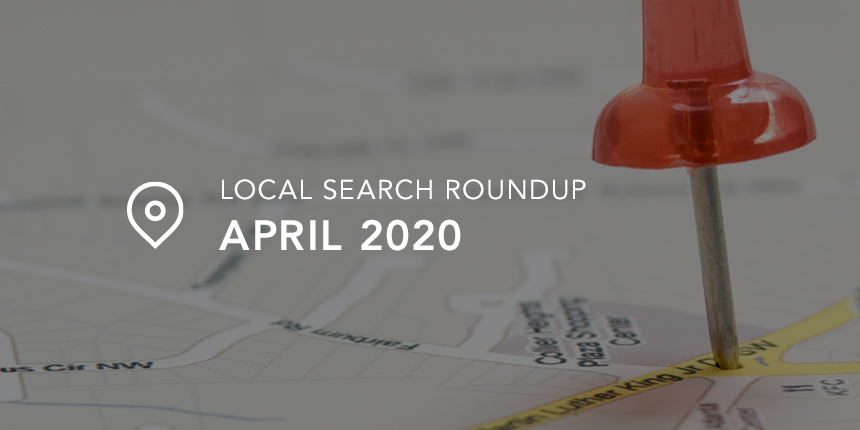Full shelter-in-place orders were in place all over the world for much of April 2020. Unsurprisingly, most local listing developments were in direct response to the pandemic. But that doesn’t mean these updates will cease to be relevant after COVID-19.
Many of Google’s product releases are general “quality of life” improvements that could potentially have been released even without global events accelerating their development. In other words, although some of the changes we cover below are temporary, others are worth utilising year-round—starting now.
Google makes it free to sell products in SERPs
Google’s official blog announced that businesses that sell their products online may now list their inventories for free. Retailers previously had to pay for ad placements on Google Shopping, but Google removed the charges in the US on April 27, with the rest of the world catching up soon. There are just a couple of provisos:
- The main results page will not change; those particular shopping ads are still paid. The free listings apply only to the Shopping tab.
- You can still pay for top placements through promoted listings.
Google has promoted its Merchant Center for some time through features like organic product listings, but the pandemic has expedited the process. Retailers are increasingly relying on ecommerce as their physical locations remain closed, so this is part of Google’s attempt to compete with other online marketplaces (Amazon, most notably). The upside is that retailers will gain free exposure while shoppers will see a more robust catalogue. Advertisers are still accommodated because sponsored products remain a very profitable initiative.
With the cost of entry removed, there’s no reason not to experiment with this marketing channel as a new customer touch point. It offers only profit as long as it’s free, and you may find that the cost is still worth it if and when Google reinstates the required payments. See our full write-up here.
Google Maps gets a host of new attributes
In another broadly beneficial update precipitated by COVID-19, restaurants are now listed in Google Maps with delivery and takeout labels. With a clickless interface, users will know immediately if the business they are viewing offers certain features. This is currently limited to indicating delivery and takeout options, but it’s easy to see this expanding into other relevant information—especially because Google also released a host of new attributes that Google My Business (GMB) managers can assign to their listings. These new attributes include:
- Dine-in
- Curbside pickup
- In-store shopping
- No-contact delivery
- Video visits
- COVID-19 info link
- Virtual care link
- Delivery
- Order ahead
- Takeout

Every attribute applicable to your business should be assigned whenever possible. Not only are these features being utilised more by Google in a way that’s immediately obvious to users, but they can influence your search rankings. Attributes such as “parking availability”, for instance, may become a map label in the future and may impact rankings depending on the query.
Google’s new “Food Orders” tab
Takeout has become fundamental to all restaurants during COVID-19. Uber Eats, SkipTheDishes, and other third-party food delivery services are more ubiquitous than ever. Because of this, Google is attempting to carve out its own share in the food delivery market. Having acquired TheOrderingApp, Google is now testing a new tab in GMB called “Food Orders”. This tab acts similarly to other delivery options with the exception that it is exclusive to TheOrderingApp. Restaurants that wish to use this new service must sign up though TheOrderingApp’s website.
Not all restaurants are fond of these third-party delivery companies because they take a percentage of already-thin margins. They also often take business away from a restaurant’s own first-party delivery option. If you run a restaurant business without its own delivery service and you accept third-party services as a necessary evil, TheOrderingApp is another option to add to your repertoire.
New virtual appointment links for healthcare providers
When going over the list of new attributes to add to your GMB listing, you may have noticed “virtual care link” and “telehealth info link”. These represent Google’s effort to help healthcare providers set up remote appointments with their patients. These links are to be used for virtual conferencing or phone appointments with healthcare providers. With many medical clinics already providing this information on their websites, Google has been able to scrub their pages to automatically detect and populate these links into the healthcare facility’s GMB profile. This is not a 100% reliable method, however, so healthcare facilities should still review these attributes themselves.

Unlike its acquisition of TheOrderingApp, Google is not providing its own conferencing software. Instead, it will simply facilitate the connection between a healthcare provider and a patient. After the information has been presented to the user, it is up to the healthcare provider to set up their preferred platform for the appointment.
10-location cap on Google Posts is temporarily lifted
COVID-19 has forced Google to solve a problem of its own making. Google Posts are a free and effective marketing tool which allow businesses to add microblog content directly on their highly visible GMB profile. Google Posts can communicate sales, special hours, events, and anything else the business wishes to promote. Posts also enjoy prominent placement on Maps as well as the business’s knowledge panel, but have until now been subject to arbitrary limitations—including the inability to bulk-post updates for businesses with more than 10 locations.
Due to the pandemic, Google temporarily rolled back this restriction to allow chains to communicate their COVID-19 response on all their listings. If any enterprise-level businesses have been ignoring Google Posts up until now due to the 10-location limit, now is the time to utilise this marketing tool. These brands may now attach COVID-related updates directly to all of their GMB profiles. Bear in mind, though, that Google has stated explicitly that this scalable functionality is only temporary.
Businesses can show temporary service changes on their Facebook pages
Facebook’s local business discovery has always lagged behind Google Maps. Basic features like special hours for holidays have been unavailable despite being standard in nearly every other map service. This failing on Facebook’s part has been addressed as the pandemic calls for a major improvement in all communication channels. Businesses making temporary changes to their usual services can now prominently display those changes on their Facebook page.
If a customer visits the Facebook page of a restaurant, they can now quickly see if it’s still offering delivery and/or pickup service. Locations that are temporarily closed can also mark themselves as such rather than having to remove their operating hours as a workaround.
Businesses have long known to maintain their GMB profiles as the functionality was there. Now Facebook has implemented some of these same features due to the overwhelming number of users who use Facebook as their primary informational source. Businesses that have neglected Facebook will now have to make sure they fully update that customer touch point as well.
Need a hand staying on top of every local platform for every one of your locations? That just happens to be our specialty. Let’s talk.




